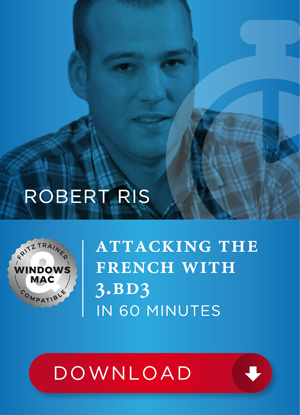The video courses in my first article, 60 Minutes Against Sicilian, mainly presented courses that deal with specific variations against the main systems of the Sicilian Defence. For this post, I have examined courses that present a complete repertoire against the French Defence. These courses are suitable for club players who want to avoid the time-consuming study of the main variations but still want to play promising variations. Stronger players will find alternatives for their repertoire here that they can use to surprise well-prepared opponents.
60 minute courses against the French
I often see players “taking refuge” in the exchange variation against the French Defence because they want to avoid the strategically complex positions of the main variations. In the courses presented here, the authors offer almost complete repertoires against the French Defence that can be learnt with relatively little effort yet still offer good opportunities for active play.
The Two Knights: Your Shortcut to Beating the French! (Robert Ris)
In his new 60-minute course, Dutch IM Robert Ris recommends the “Two Knights System” with 2.Nf3 and 3.Nc3.
.jpg)
Against Caro-Kann, this system is one of the main variations, but against French it is less well known. The author first discusses the less frequently played variations 3…dxe4 and 3…Bb4. Here it becomes apparent that the white move Nf3 has several advantages over the more common move d4.
The advance 3…d4, which appears more promising here than in the corresponding Caro-Kann variation, since the c-pawn can move to c5 in one move after 4.Ne2, is perhaps the critical test of the system. But here too, the author has a good suggestion with 5.c3:
.jpg)
The most common variation is 3…Nf6, which we respond to with a transition to the Steinitz Variation with Nf3: 4.e5 Nfd7 5.d4:
.jpg)
The positions that arise here are easier to play than the variations with f4. Tactical opportunities often arise. For example, if Black carelessly continues with 8…0-0? in this position:
.jpg)
… he would fall victim to a well-known sacrifice: 9.Bxh7!
Struggling against the French Defence? The Two Knights Variation might just change everything! By developing the knights to c3 and f3, White follows a simple yet effective plan: rapid development without heavy theory. Unlike traditional French lines, White no longer supports the centre with the c- and f-pawns. Instead, when Black challenges the centre with the typical …c5 and/or …f6 breaks, White is ready to strike – aiming to capture and play actively against Black’s hanging pawns on d5 and e6. These resulting positions give White excellent chances to seize control of the dark squares and create powerful attacking prospects. In this 60-minutes video you’ll learn all the critical lines, core strategic ideas, and tactical patterns – without drowning in endless theory. If you are looking for a practical, easy-to-learn system to sidestep the main lines and catch your opponent off guard, the Two Knights Variation is your perfect weapon against the French!
Free video sample: Intro
Without going into detail, I would like to mention the slightly older course:
Classical Steinitz French with 5.Nf3 (Nigel Davies)

This course discusses the Steinitz Variation with 5.Nf3 (instead of 5.f4), which can arise in Robert Ris’s course through transposition.
.jpg)
The Classical Variation of the French Defence (1.e4 e6 2.d4 d5 3.Nc3 Nf6) has many different playable options for Black after either 4.Bg5 of 4.e5 Nfd7 5.f4. Yet by playing 4.e5 Nfd7 5.Nf3 White can sidestep these and get the game back onto his own turf. In the main line, White can choose between two different approaches, purely positional play or a violent plan involving castling long. The first of these plans has been used extensively by Australian GM Ian Rogers whilst Alexandra Kosteniuk has played the second with great effect. Both these plans are explained making this product suitable for players of every style. A number of transpositions are also mentioned by which the lines covered can be reached via a 1.e4 e6 2.Nf3 move order or even an Alekhine’s Defence!
Attacking the French with 3.Bd3 (Robert Ris)
Robert Ris is also the author of the second current course on French. Here, the author examines the 3.Bd3 variation as an alternative to the common main variations. This variation usually leads to positions that are relatively easy to learn and is therefore well suited for players who want to get by with minimal theory study – without taking any major risks.
Black has three logical responses here (3…Nf6, 3…c5 and 3…dxe4), each of which is presented in a separate video.
.jpg)
The course also includes a database with 35 games, in which this variation was played.
Do you always have problems finding a good antidote to the French (1.e4 e6 2.d4 d5)? Thanks to this 60 minutes course on the move 3.Bd3 you don’t have to look any further!
Beating the French according to Kupreichik (Andrew Martin)
English IM and trainer Andrew Martin takes a slightly different approach: He recommends a rare variation in the popular advance variation, in which White, after 1.e4 e6 2.d4 d5. 3.e5 c5 4.c3 Nc6, does not play the usual 5.Nf3, but instead chooses the variation 5.Be3!? developed by GM Victor Kupreichik.
.jpg)
The idea is to support d4 with Be3 and Qd2 without blocking the f-pawn and retaining the option of f2-f4. Using eight games by Kupreichik, Andrew Martin shows why many French Defence fans may not be familiar with this variation and why it is very dangerous for Black. However, the course is not quite complete as a comprehensive repertoire, because in the case of 4…Qb6 instead of 4…Nc6, White must deal with the “normal” variations, as 5.Be3 would simply lose the b2 pawn.
1.e4 e6 2.d4 d5 3.e5 c5 4.c3 Nc6 5.Be3!?. Andrew Martin uses the games of Kupreichik to show why this line could catch many French aficionados unprepared and is very dangerous for Black.
The Korchnoi Gambit against the French (Sam Collins)
This course by Irish IM Sam Collins does not provide a 100% complete repertoire against the French Defence either. The Korchnoi Gambit is based on the Tarrasch Variation with 3.Nd2 and subsequently the “Universal System”, in which White develops the king’s knight to f3 and not to e2. It is playable after Black’s moves 3…Nf6, …Be7 and in some variations with …c5, but there are ways for Black to avoid the gambit.
.jpg)
It is a gambit because, in this position, White cannot defend the d-pawn well after 7…Qb6 and must sacrifice it.
.jpg)
However, accepting the gambit is very dangerous for Black and offers White very good attacking opportunities. The author describes the resulting positional types using five illustrative games.
The French Defence is one of Black’s most popular and uncompromising responses to 1.e4, and it’s important to have a viable weapon prepared. In this presentation, IM Sam Collins explains the Korchnoi Gambit, which is characterised by White placing his king’s knight on f3 in the Tarrasch variation.
Additional 60-minute courses on the French defence
As a supplement, I would like to mention two further 60-minute courses which, although primarily aimed at French players, may also be of interest to e4 players. They provide an insight into the mindset and preparation of opponents.
Fascinated by the French Winawer (Alexei Shirov)
In seven video clips, Shirov focuses primarily on the very sharp and tactical play of the Winawer/Nimzowitsch Variation 3.Nc3 Bb4, e.g. the surprisingly strong 4.a3 and the position after 4.e5 c5 5.a3 Bxc3+ 6.bxc3 Ne7.
The Fort Knox Variation in the French Defence (Lawrence Trent)
The Fort Knox variation presented by Lawrence Trent is much more solid and quiet: 3.Nc3 (or 3.Nd2) 3…dxe4 4.Nxe4 Bd7. Many e4 players find it quite difficult to achieve a promising position against this variation. It is worth taking a look at the other side of the board.
Conclusion
The 60-minute French courses offer a good selection of alternatives to the classic main variants, which are sure to surprise some opponents and lead them into unfamiliar territory – without taking any great risks yourself.





